코르티잔(courtesan)
얼핏 보기에 이 단어는 매우 음란하게 느껴진다. 그러나 머리에 스치는 이러한 다소 외설적인 상상으로는 이 단어의 함축된 의미를 다 헤아릴 수 없다. 어떤 사전에는 코르티잔을 '부유한 남자들이나 귀족들과 관계를 가진 창부(娼婦)'였다고 하고, 또 어떤 사전을 보면 '정부(情婦)'라고 나와있다. 하지만 코르티잔은 양쪽 모두였거나 그 어느 쪽도 아니었다.
코르티잔을 단순히 창부였다고만 말할 수는 없다. 루이 15세의 애첩이었던 마담 뒤바리가 한때 상류층
남자들을 상대로 매춘을 한 것은 사실이다. 그리고 후에 백작부인이 된 모가도르는 젊었을 때 사창가에서
일하였다. 그러나 그들에게 코르티잔이 되었다는 것은 대단한 출세였고 높은 삶으로의 도약이었다. 엄밀히 말해, 코르티잔은 사창가에 살거나 거리로 나가지 않았고, 엄밀히 말하자면 뒤에서 조종하고 착취하는 포주가 없었다. 또 코르티잔들은 정부나 아내에 가까운 좀더 지속적이로 친밀한 역활을 하였다.
그리고 그들이 받은 대가는 응분의 보상 차원을 훌쩍 뛰어넘는 것이었다. 예를 들어 루이 15세는 마담 드 퐁파두르를 만난 지 얼마 안되서 현재 프랑스 대통령의 거처인 엘리제 궁을 포함하는 사유지를 하사했고 이후에서 여러차례 부동산을 받았다. 카스틸리오네 백작부인이 리자드 윌리스와 12시간을 보내는 화대로 1백만 프랑을 받기도 하였다. 성공한 코르티잔은 그들이 소유한 시내 아파트와 성과 별장에 값비싼 장식을 하고 화려한 드레스와 보석들로 치장을 하기도 했다. 그들에게 이런 패물은 성공의 상징이며 은퇴 후의 자금이기도 했다.
코르티잔은 유부남의 숨겨둔 정부와는 달랐다. 코르티잔들은 그들이 치장하고 다니는 보석과 마찬가지로 자랑거리였다. 그들은 버젓이 연인과 함께 공공장소와 사교장소, 카페, 레스토랑, 무도회장을 드나들었고, 집에서 그의 친구들을 접대하기도 했다. 19세기 실엄가들 사이에서는 코르티잔을 두는 것이 일종의 예의였다. 동성애자들까지도 그렇게 해야 체면이 서는 것처럼 느꼈다. 하지만 정부와 코르티잔의 가장 큰 차이점은 코르티잔이 유명인사였다는 사실이다. 요즘으로 말하자면 인기 연예인인 셈이었다. 그들은 왕, 섭정, 황제, 관료, 자본가, 작가와 화가의 친구로 염문을 뿌리고 다녔고, 그들의 옷차림과 행동은 계속해서 대중의 호기심을 자극했고 끊임없이 주간지의 기삿거리가 되었다.
코르티잔은 수준 높은 교양을 갖추어야 했다. 그들은 상류층의 말투와 옷입는 법, 유행하는 헤어스타일, 우아하게 걷는 법, 춤과 피아노 연주를 배워야 했다. 식사 예절은 물론 궁중의례를 포함하는 여러가지 예법을 알아야 했다. 전에는 글조차 읽지 못했을지라도, 오페라와 문학과 역사에 조예가 깊어야 했다. 실제로 많은 코르티잔들은 뛰어난 지성을 보인다. 모가도르를 비롯한 일부 쿠르티잔들은 소설을 썼고, 툴리아 다라고나는 수필을 발표했으며, 베로니카 프랑코는 시인으로 인정받았다. 또 많은 코르티잔들이 자서전을 집필했다. 그들은 확실히 특출한 인물이었다. 그들이 활약하는 시기, 여성에게는 많은 제약과 통제가 있었다. 그러나 코르티잔들은 시몬느 드 보부아르의 말대로 스스로 "자유롭게 말하고 행동하면서 남자와 거의 동등한 위치에서 여성으로서 유례없는 지적 자유"를 누릴 수 있었다.
만일 코르티잔이 존재하지 않았다면 현대 문학이나 현대인의 감성은 지금과 달라졌을 것이다. 보들레르의 시, 발자크, 뒤마 부자, 졸라, 플로베르, 콜레트의 소설에는 코르티잔들이 등장한다. 지금 우리 세대의 미학을 정의하고 있는 <잃어버린 시간을 찾아서>에는 줄거리의 중심에 한 코르티잔이 있다. 또 다수의 오페라 작품들과 연극 대본들은 모두 코르티잔의 이야기와 전설에 바탕을 두고 있다.
--------------------------------------------------------------
19세기 초에 프랑스의 농촌 경제가 무너지기 시작하면서 파리를 비롯한 도시들이
지방에서 일거리를 찾아온 난민들로 넘쳐납니다.
노동자들은 하루 16시간씩 일하면서도 입에 풀칠하기도 어려운 임금을 받습니다.
주로 의류업체에 일하던 여성들이 그들이 입던 어두운 회색 옷 때문에 '그리제트(grisette)'라고 불렸습니다. 아마 우리나라로 치면 전태일 열사가 평화시장 의류제조 현장에서
분신 자살을 해야 했던 시절을 생각하면 이해가 쉽겠네요.
'그리제트'는 당시의 이런 어두운 상황으로 말미암아 전혀 다른 의미로 변질됩니다.
20세기 중반까지도 사전에는 그리제트가 여전히 '문란한 여성'이라고 되어 있었습니다.
많은 코르티잔이 과거에 여공이었던 것은 바로 이런 연유입니다.
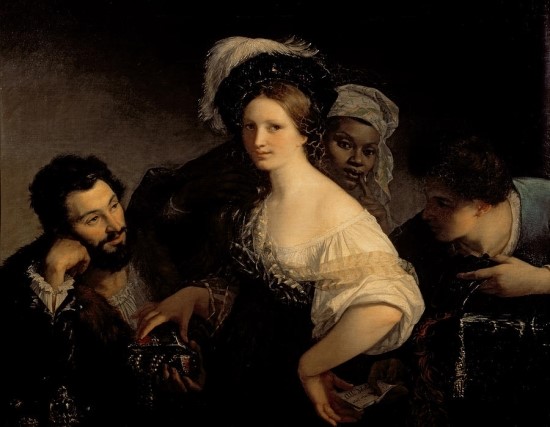
그자비에 시바롱 <젊은 코르티잔>
만일 운이 좋거나 특출한 미모를 가졌다면 좋은(?) 남자를 사다리 삼아
신분 상승을 이루는 행운을 잡게 되는데, 그들을 '로레트(lorette)'라고 부릅니다.
코르티잔의 후보, 정부라는 뜻입니다.
이 로레트 중에서 가장 재능이 있는 소수만이 코르티잔이 되는 것이죠.
코르티잔(Courtesan), 사전적 의미로는 '부유한 남자들이나 귀족들과 관계를
가진 창부(娼婦)' 였다고 하고, 어떤 사전에서는 '정부(情婦)'라고 나와 있습니다.
하지만, 코르티잔은 양쪽 모두이었거나 그 어느 쪽도 아니었습니다.
왜냐하면 코르티잔이 된다는 것은 대단한 출세였고 예전에는 상상할 수조차 없는
삶으로 도약하는 행운이었기 때문입니다.
그녀들은 엄청난 대가를 받았고, 성공한 코르티잔은 때로는 자신들의 후견인보다
더 떵떵거리고 살았다고 합니다. 하룻밤으로 끝나는 상대가 아니라는 점에서 코르티잔은
정부와 흡사하다고 할 수 있지만, 때에 따라서는 정부 이상도
그 이하도 될 수 있었습니다.
정부 이하라는 의미는 정절을 지키지 않았다는 뜻입니다.
그들 대부분은 연인을 여러 명씩 두고 있었고, 그중 어떤 상대에게는 돈을 받았고
어떤 상대에게는 받지 않았습니다.
정부과 코르티잔의 가장 큰 차이점은 코르티잔은 유명인사였다는 사실일 것입니다.
요즘으로 말하면 인기 연예인인 셈이었죠.
수준 높은 교양을 갖춘 그들은 왕, 섭정, 황제, 국가 관료, 자본가, 유명 작가와 화가의
친구로 염문을 뿌리고 다녔고, 그들의 옷차림과 행동은 계속해서 대중들의 호기심을 자극했습니다.
코르티잔의 존재는 결혼이 가문과 재산을 보호하기 위한 일종의 거래로 여겨지며
결혼과 연애가 별개의 것으로 공존했던 유럽 신분사회의 질병 같은 하나의 현상이었습니다.
코르티잔으로 대표되는 상류층의 왜곡되고 문란한 성문화는 실제로 사생아 등의 문제를
야기했는데, 남편의 혼외자식이 유산 상속의 대상이 될 수 있는 점이 특히 민감한 부분이었습니다.
이에 따라 본처가 코르티잔을 용인하는 대신 아이를 낳지 않는 것이 불문율이었고,
또 경제적 후원이 끊어지거나 더 나은 후원자가 나타나면 관계를 끝내고 떠나는 것이 다반사였죠.
"그녀는 매력적이고 눈부신 외모에 위트까지 겸비하고 있었다.
당시는 코르티잔의 마지막 전성기였고 그녀는 그 호기를 놓치지 않았다."
유명한 언론인 재닛 플래너의 칼럼 중에 나오는 내용입니다.
현실을 직시하고 그 상황에 충실했던 당시의 시대상을 보여주는 대표적인 부류가
바로 코르티잔이었습니다. 사회가 만들어낸 특수직업인 셈이죠.
[출처] [동백꽃] 코르티잔(Courtesan)|작성자 보보스
[역사상의 유명 코르티잔들(Famous courtesans in history)]
17th century and before
- Amrapali (5th century BC)
- Lais of Corinth
 by Hans Holbein the Younger, Kunstmuseum Basel
by Hans Holbein the Younger, Kunstmuseum Basel - Lais of Hyccara (killed 340 BC)
 1902 print of Lais
1902 print of Lais - Thaïs
 leading the destruction of the palace of Persepolis,
leading the destruction of the palace of Persepolis, - as imagined by Joshua Reynolds.
- Aspasia (469 BC-409 BC),
 lover of the Athenian statesman Pericles.[Marble herm in the Vatican Museums inscribed with Aspasia's name at the base. Discovered in 1777, this marble herm is a Roman copy of a 5th-century BC original and may represent Aspasia's funerary stele.]
lover of the Athenian statesman Pericles.[Marble herm in the Vatican Museums inscribed with Aspasia's name at the base. Discovered in 1777, this marble herm is a Roman copy of a 5th-century BC original and may represent Aspasia's funerary stele.] - Phryne (4th century BC)
 A copy of the Aphrodite of Knidos.
A copy of the Aphrodite of Knidos. - Phryne is said to be the model of the original
- Diaochan
 (born 169 AD, the lover of warlord Dong Zhuo and warrior Lü Bu during the Chinese Three Kingdoms)
(born 169 AD, the lover of warlord Dong Zhuo and warrior Lü Bu during the Chinese Three Kingdoms) - Su Xiaoxiao (late 5th century)(Chinese: 蘇小小, died c. 501),[1] also known as Su Xiaojun and sometimes by the appellation "Little Su", was a famous Chinese courtesan and poet from Qiantang City (now Hangzhou, Zhejiang Province) in the Southern Qi Dynasty (479–502). She had a sister named Su Pannu.
- Theodora (6th century)(c. 500–June 28, 548), wife of Emperor Justinian I of the Byzantine Empire
 The Empress Theodora at the Colosseum,
The Empress Theodora at the Colosseum, - oil painting by Jean-Joseph Benjamin-Constan
- Agnès Sorel (1422–1450)
mistress to King Charles VII of France, first official royal mistress in FranceAgnès Sorel 
- Jane Shore (1445–1527): mistress of King Edward IV of England
 [The Penance of Jane Shore by William Blake, c.1780.]
[The Penance of Jane Shore by William Blake, c.1780.] - Margaret Drummond (Mistress) (1475–1502): mistress to King James IV of Scotland
- Françoise de Foix (1495–1537): first official mistress of King Francis I of France
- Diane de Poitiers (1499–1566):
 official mistress of King Henry II of France
official mistress of King Henry II of France - Mary Boleyn (1499–1543):
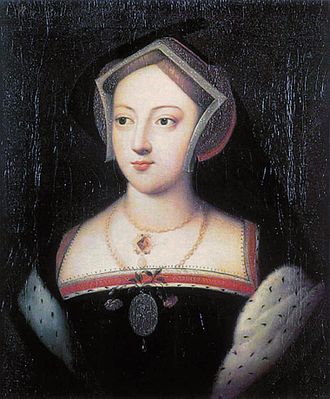 mistress of King Henry VIII of England and (allegedly) lover of King Francis I of France
mistress of King Henry VIII of England and (allegedly) lover of King Francis I of France - Hwang Jin-i (1550): legendary gisaeng of the Joseon Dynasty
- Anne de Pisseleu d'Heilly (1508–1580):
 last official mistress of King Francis I of France[Portrait of Anne attributed to Corneille de Lyon (Metropolitan Museum of Art)
last official mistress of King Francis I of France[Portrait of Anne attributed to Corneille de Lyon (Metropolitan Museum of Art) - Tullia d'Aragona (c. 1510–1556):
 top courtesan in several
top courtesan in several - Italian cities, and published poet[그림;Tullia d'Aragona, portrayed as Salome L'Erodiade by Moretto da Brescia
- Veronica Franco (1546–1591):
 Portrait by Tintoretto, ca. 1575
Portrait by Tintoretto, ca. 1575
- Marie Touchet (1549–1638):

- Marion Delorme (circa 1613–1650):
 [Wood engraving of the character Marion de Lorme from Victor Hugo's play of the same name].
[Wood engraving of the character Marion de Lorme from Victor Hugo's play of the same name].
- Ninon de l'Enclos (1615–1705):
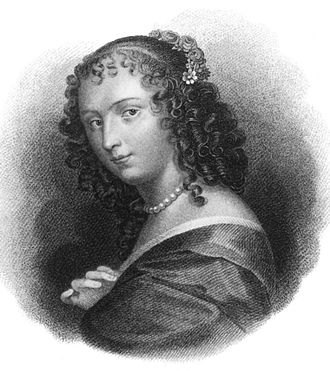 [Etching by Antoine-Jean-Baptiste Coupé (1784 -ca. 1852)] lover of the Prince of Condé and Gaspard de Coligny
[Etching by Antoine-Jean-Baptiste Coupé (1784 -ca. 1852)] lover of the Prince of Condé and Gaspard de Coligny - Lucy Walter (1630–1658)
mistress to King Charles II of England during his exile
- Barbara Palmer, 1st Duchess of Cleveland (1640–1709):
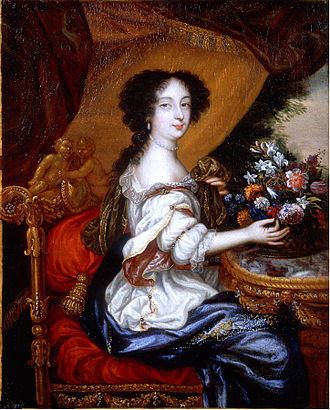 [Portrait by Henri Gascar] first official mistress at the court of King Charles II of England
[Portrait by Henri Gascar] first official mistress at the court of King Charles II of England - Françoise-Athénaïs, marquise de Montespan (1641–1707):

- mistress to King Louis XIV of France
- Louise de la Vallière (1644–1710):
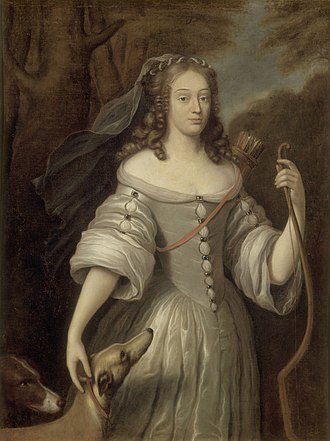 mistress to King Louis XIV of France
mistress to King Louis XIV of France - Nell Gwyn (1650–1687):
 actress, mistress to King Charles II of England
actress, mistress to King Charles II of England
[18th and 19th centuries]
- Claudine Alexandrine Guérin de Tencin (1681–1749)

- Louise Julie, Comtesse de Mailly (1710–1751)

- Marie-Anne de Mailly-Nesle duchess de Châteauroux (1717–1744)

- Kitty Fisher (died 1767)

- Madame de Pompadour (1721–1764):
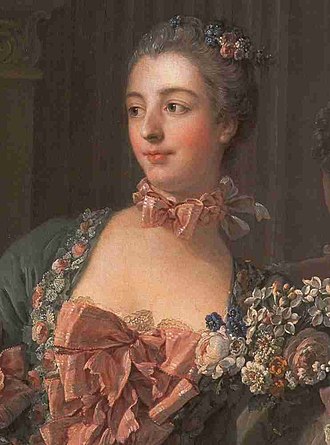 [Detail from a portrait by François Boucher] the famous mistress and longtime favorite of King Louis XV
[Detail from a portrait by François Boucher] the famous mistress and longtime favorite of King Louis XV - Marie-Louise O'Murphy (1737–1814)

François Boucher, Louise O'Murphy c. 1752, oil on canvas, 59 x 73 cm., (23.23 × 28.74 in),
-
- Madame du Barry (1743–1793)
 Madame du Barry by Élisabeth Vigée Le Brun,
Madame du Barry by Élisabeth Vigée Le Brun, - Sophia Baddeley (1745–1786)
 Mrs Baddeley in the role of Joan of Arc
Mrs Baddeley in the role of Joan of Arc - Støvlet-Cathrine (1745–1805)

- Frances Villiers, Countess of Jersey (1753–1821)
 Lady Jersey by Thomas Beach.
Lady Jersey by Thomas Beach. - Grace Elliott (1754?–1823)

- Dorothy Jordan (1761–1816)
 Mrs. Jordan in the Character of Hippolyta, painting by John Hoppner, first exhibited 1791 (previously in the National Gallery and Tate collections, now on loan to the National Portrait Gallery[1])
Mrs. Jordan in the Character of Hippolyta, painting by John Hoppner, first exhibited 1791 (previously in the National Gallery and Tate collections, now on loan to the National Portrait Gallery[1]) - Harriette Wilson (1786–1846)
 Portrait engraved by Cooper, from original drawing by Birch
Portrait engraved by Cooper, from original drawing by Birch - Umrao Jaan (1804–1875) Lucknow, India
 Umrao Jaan film poster
Umrao Jaan film poster - La Païva (1819–1884)
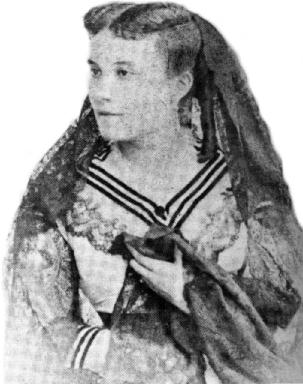 Esther Lachmann, in the 1850s
Esther Lachmann, in the 1850s - Lola Montez (1821–1861)

- Marie Duplessis (1824–1847)
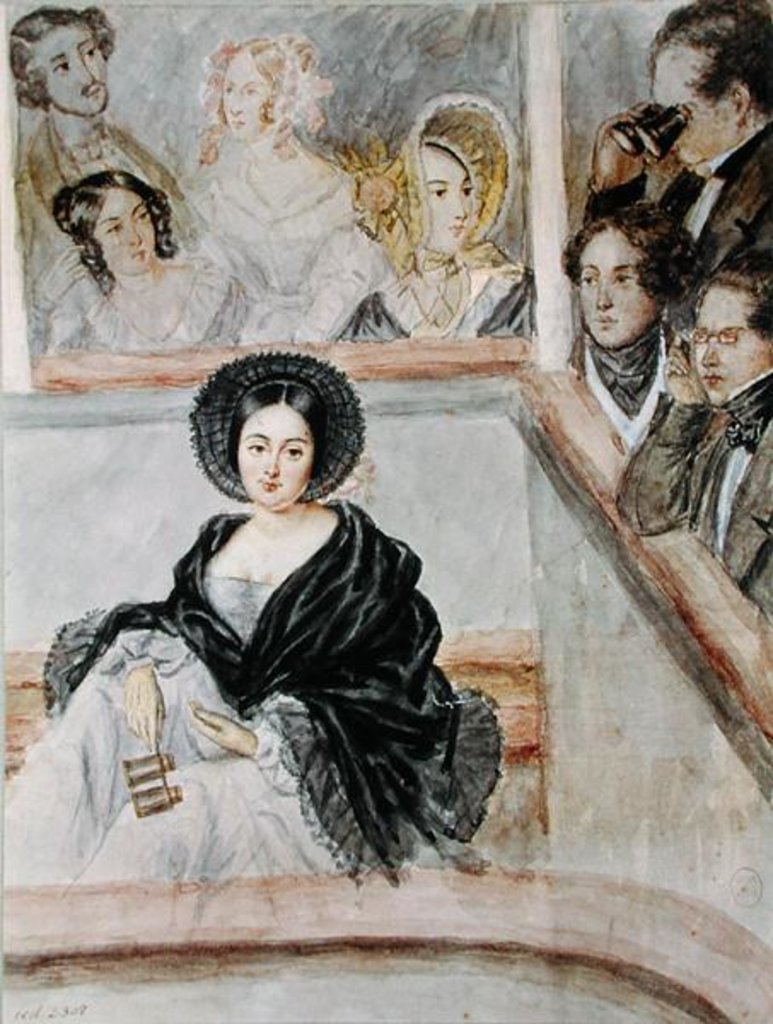
Cora Pearl (1835–1886) 19th-century courtesan of the French demimonde who enjoyed her greatest celebrity during the period of the Second French Empire.
19th-century courtesan of the French demimonde who enjoyed her greatest celebrity during the period of the Second French Empire.
- Eliza Lynch (1835–1886)
 was the mistress of Francisco Solano López, president of Paraguay.
was the mistress of Francisco Solano López, president of Paraguay. - Virginia Oldoini, Countess di Castiglione (1837–1899)

- Catherine Walters (1839–1920)
 was a fashion trendsetter
was a fashion trendsetter - and one of the last of the great courtesans of Victorian London
- Blanche d'Antigny (1840–1874)
 [Penitent Magdalene by Baudry, the model was Blanche d'Antigny]was a French singer and actress whose fame today rests chiefly on the fact that Émile Zola used her as the principal model for his novel Nana.
[Penitent Magdalene by Baudry, the model was Blanche d'Antigny]was a French singer and actress whose fame today rests chiefly on the fact that Émile Zola used her as the principal model for his novel Nana. - Lillie Langtry (1853–1929)
 A Jersey Lily by Millais
A Jersey Lily by Millais - Katharina Schratt (1853–1940), companion of Emperor Franz Josef

- Mary Cornwallis-West (1858-1920), aka as Patsy Cornwallis
 was a mistress of the future King Edward VII.
was a mistress of the future King Edward VII. - Daisy Greville, Countess of Warwick (1861–1938)
 was a British socialite and long-time mistress to Albert Edward, Prince of Wales, who later became King Edward VII.
was a British socialite and long-time mistress to Albert Edward, Prince of Wales, who later became King Edward VII. - La Belle Otero (1868–1965)
 was a Spanish-born dancer,
was a Spanish-born dancer, - actress and courtesan.
- Alice Keppel (1869–1947)
 was a British society hostess
was a British society hostess - and a long-time mistress of King Edward VII.
- Liane de Pougy (1869–1950)
 was a Folies Bergère dancer
was a Folies Bergère dancer - renowned as one of Paris's most beautiful and notorious courtesans.
- Clara Ward, Princesse de Caraman-Chimay (1873–1916)

- was a wealthy American socialite who married a prince from Belgium.
- "Klondike Kate" Rockwell (1873–1957)

- Mata Hari (1876–1917)

In addition to the list above, the term "courtesan" has often been used in a political context in an attempt to damage the reputation of a powerful woman, or disparage her importance. Because of this, there is still much historical debate over whether certain women in history can be referred to as courtesans.
For example, the title was applied to the Byzantine empress Theodora, who had started life as an erotic actress but later became the wife of the Emperor Justinian and, after her death, an Orthodox saint. The term has also been applied to influential women like Anne Boleyn, Madaline Bishop, Diane de Poitiers, Mathilde Kschessinska, Pamela Harriman, Eva Perón and Gabrielle "Coco" Chanel. The attempt to define such women as courtesans is often intended to draw attention to certain perceived qualities, ambitions or conduct which are held to be courtesan-like.
[Famous courtesans in fiction]
- Madame Gabrielle from Dora Levy Mossanen. Courtesan: A Novel. Touchstone, 2005. ISBN 0-7432-4678-0
- Odette Swann from Marcel Proust's In Search of Lost Time is a courtesan of the French Belle Epoque, she gains a notorious reputation from cavorting with Aristocrats, artists, Bourgeois, and both sexes.
- The Lady of the Camellias was a novel about a courtesan by French author Alexandre Dumas, fils that was turned into the opera La Traviata by Italian composer Giuseppe Verdi. In the novel, the courtesan's name is Marguerite Gautier; in the opera, it is "Violetta Valéry". "La Traviata" in Italian translates "The Wayward
- One".
- Satine played by Nicole Kidman, an actress/courtesan who falls in love with a penniless poet/writer played by Ewan McGregor, in Baz Luhrmann's 2001 film, Moulin Rouge!.
- The movie Dangerous Beauty, starring Catherine McCormack, tells the story of Veronica Franco, a Venetian courtesan.
- Angellica Bianca in Aphra Behn's 1677 play The Rover.
- Vittoria Corombona in John Webster's play The White Devil. She is described in the alternative title of the play as 'the famous Venetian Curtizan'.
- Nana, in Emile Zola's eponymous novel of 1880 is a courtesan.
- In Sarah Dunant's In the Company of the Courtesan, Fiammetta Bianchini, a renowned courtesan of Rome, and her sharp-witted dwarf rise to success among the intrigue and secrets of Renaissance Venice.
- In John Cleland's Fanny Hill: or, the Memoirs of a Woman of Pleasure, Fanny goes from poor orphaned country girl to wealthy skilled courtesan eventually finding her one true love and retiring to marriage. Her history is told in the first person through several letters to friends detailing her life as a courtesan.
- In the book A Great and Terrible Beauty, Pippa accuses Felicity of having a mother who is a courtesan and a consort, and who ran away to France not only to run a salon but to be with her lover, a Frenchman.
- Inara Serra is a 26th-century Alliance companion, a position inspired by courtesans, in Joss Whedon's TV series Firefly.
- Phèdre nó Delaunay, the premier courtesan of Terre D'Ange in Jacqueline Carey's Kushiel's Legacy novels.
- The Broadway plays, musicals, and movies based upon the book Gigi are about a young Parisian girl who is being trained to be a courtesan by her great-aunt, a retired career courtesan herself.
- Bianca, who appears in Anne Rice's The Vampire Armand, is a courtesan.
- Bianca in William Shakespeare's Othello, is considered a courtesan to Cassio.
- Many examples in Indian Literature and Bollywood films: Sahibjaan in Pakeezah, Umrao Jaan in the film of the same name, Chandramukhi in Devdas.
- Mira Nair's 1996 film Kama Sutra: A Tale of Love highlights the profession of courtesans in 16th-century India, featuring Rasa Devi (Rekha) and Maya (Indira Varma)..
- Ulla Winblad, in the famous 18th-century poems of Carl Michael Bellman.
- Kamala, in Herman Hesse's Siddhartha.
- Sha'ira, an asari "Consort" from the Mass Effect computer game series.
- Paola and Sister Teodora were the leaders of the courtesans of Florence and Venice (respectively) in the video game Assassin's Creed II. In its sequel, Assassin's Creed: Brotherhood, Madame Solari is shown to be the leader of the courtesans in Rome. Courtesans also provide a gameplay mechanic in the two games, main character Ezio Auditore can hire small groups of courtesans that can be used to escort the assassin without being noticed, and to distract hostile guards.
- Komagata Yumi in the anime Rurouni Kenshin: Meiji Kenkaku Roumantan.
[영문해설 자료 - 위키백과]
A courtesan was originally a courtier, which means a person who attends the court of a monarch or other powerful person.[1]
In feudal society, the court was the centre of government as well as the residence of the monarch, and social and political life were often completely mixed together. Prior to the Renaissance, courtesans served to convey information untrusted to servants to visiting dignitaries. In Renaissance Europe, courtiers played an extremely important role in upper-class society. As it was customary during this time for royal couples to lead separate lives—commonly marrying simply to preserve bloodlines and to secure political alliances—men and women would often seek gratification and companionship from people living at court. In fact, the verb to court originally meant "to be or reside at court", and later came to mean "to behave as a courtier" and then courtship, or "to pay amorous attention to somebody".[2] The most intimate companion of a ruler was called the favourite.[citation needed]
In Renaissance usage, the Italian word cortigiana, feminine of cortigiano ("courtier") came to refer to a person who attends the court, and then to a well-educated and independent woman, eventually a trained artist or artisan of dance and singing, especially one associated with wealthy, powerful, or upper-class society who provided luxuries and status in exchange for entertainment and companionship.[3] The word was borrowed by English from Italian through the French form "courtisane" during the 16th century, especially associated to the meaning of "donna di palazzo".[1]
A male figure comparable to the courtesan was the Italian cicisbeo, the French chevalier servant, the Spanish cortejo or estrecho. It actually seems that the figure of the chevalier servant (French, literally "serving cavalier", lady's escort) of a married lady was quite common in Europe up to the 18th century.[4]
The courtesans of East Asia, particularly those of the Japanese empire, held a different social role than that of their European counterparts. Examples of Japanese courtesans included the Oiran class, who were more focused on the aspect of entertainment in comparison with European courtesans.[5]
Today, the term courtesan has become a euphemism to designate a comforter, escort, mistress or a prostitute, especially one of dignified etiquette who attracts wealthy, powerful, or influential clients.[why?]
Categories
There were two types of courtesan. In one category was a type of courtesan known (in Italy) as the cortigiana onesta, or the honest courtesan, who was cast as an intellectual. In the other was the cortigiana di lume, a lower class of courtesan. Although the latter was still considered better than an average courtesan, the former was the sort most often romanticized and treated more-or-less equal to women of the nobility. It is with this type of courtesan that the art of "courtisanerie" is best associated.
The cortigiane oneste were usually well-educated and worldly (sometimes even more so than the average upper-class woman), and often held simultaneous careers as performers or artists. They were typically chosen on the basis of their "breeding"—social and conversational skills, intelligence, common-sense, and companionship—as well as their physical attributes. It was usually their wit and personality that set them apart from regular women. Sex constituted only a facet of the courtesan's array of services. For example, they were well-dressed and ready to engage and participate in a variety of topics ranging from art to music to politics.
In some cases, courtesans were from well-to-do backgrounds, and were even married—but to husbands lower on the social ladder than their clients. In these cases, their relationships with those of high social status had the potential to improve their spouses' status—and so, more often than not, the husband was aware of his wife's profession and dealings.[6]
Differences in status
As primary employment
Courtesans from non-wealthy backgrounds provided charming companionship for extended periods, no matter what their own feelings or commitments might have been at the time, and sometimes had to be prepared to do so on short notice. They were also subject to lower social status, and often religious disapproval, because of the perceived immoral aspects of their profession and their reliance upon courtisanerie as a primary source of income. In cases like this, a courtesan was solely dependent on her benefactor or benefactors financially, making her vulnerable; Cora Pearl is a good example.
Often, courtesans serving in this capacity began their career as a prostitute, or were passed from one benefactor to another, thereby resulting in them being viewed in society circles as lower than both their benefactor and those of wealth and power with whom they would socialize. Often, in instances of this sort, if the courtesan had satisfactorily served a benefactor, that benefactor would, when ending the affair, pass them on to another benefactor of wealth as a favor to the courtesan, or set them up in an arranged marriage to a semi-wealthy benefactor. In the event that the courtesan had angered or dissatisfied a benefactor, they would often find themselves cast out of wealthy circles, returning more often than not to street prostitution.
For social or political benefits
Those from wealthy backgrounds, either by birth or marriage, and who were acting as courtesans only for the social or political advancement of themselves and/or their spouses were generally treated as equals. They were more respected by their extramarital companions, both placing one another's family obligations ahead of the relationship and planning their own liaisons or social engagements around the lovers' marital obligations.
Affairs of this sort would often be short-lived, ending when either the courtesan or the courtesan's spouse received the status or political position desired, or when the benefactor chose the company of another courtesan, and compensated the former companion financially. In instances like this, it was often viewed simply as a business agreement by both parties involved. The benefactor was aware of the political or social favors expected by the courtesan, the courtesan was aware of the price expected from them for those favors being carried out, and the two met one another's demands, an example being Madame de Pompadour.
This was generally a safe affair, as both the benefactor's spouse and the courtesan's spouse usually were fully aware of the arrangement, and the courtesan was not solely dependent on the benefactor. It, rather, was simply an affair of benefits gained for both those involved. Publicly and socially, affairs of this sort were common during the 17th, 18th and 19th centuries, as well as the early 20th century, and were generally accepted in wealthy circles.[6]
Intrigues
Very often, courtesans would betray one another in acts of political intrigue in attempts to climb into higher positions of power within royal courts. There are many cases throughout history where one courtesan would attempt (sometimes successfully) to supplant the mistress to a king or emperor. This was typically preceded by her discrediting the ruler's companion, often by divulging secrets that could lead to her rival being cast aside and replaced by her. However, this was a delicate process, and if a courtesan of "lower status" attempted to replace a courtesan who wielded a substantial amount of power within the court, it would often result in the lower courtesan being exiled from the royal court, or married off to a lesser noble in an arranged marriage, or even murdered. There are also many examples of courtesans who took advantage of their involvement with powerful individuals, which usually ended in their downfall.[citation needed]
Career length
In later centuries, from the mid-18th century on, courtesans would often find themselves cast aside by their benefactors, but the days of public execution or imprisonment based on their promiscuous lifestyle were over. There are many examples of courtesans who, by remaining discreet and respectful to their benefactors, were able to extend their careers into or past middle age and retire financially secure; Catherine Walters is a good example. By the late 19th century, and for a brief period in the early 20th century, courtesans had reached a level of social acceptance in many circles and settings, often even to the extent of becoming a friend and confidant to the wife of their benefactor.[6]
More often than not, a woman serving as a courtesan would last in that field only as long as she could prove herself useful to her companion, or companions. This, of course, excludes those who served as courtesans but who were already married into high society. When referring to those who made their service as a courtesan as their main source of income, success was based solely on financial management and longevity. Many climbed through the ranks of royalty, serving as mistress to lesser nobles first, eventually reaching the role of mistress to a king or prince. Others were able to obtain such a high position early on, but few lasted long, and after serving a prince or king there was nowhere to go but down.
Pietro Aretino, an Italian Renaissance writer, wrote a series of dialogues (Capricciosi ragionamenti) in which a mother teaches her daughter what options are available to women and how to be an effective courtesan. The French novelist Balzac wrote about a courtesan in his Splendeurs et misères des courtisanes (1838–47). Emile Zola likewise wrote a novel, Nana (1880), about a courtesan in nineteenth-century France.
See also
- Grisette (French)
- Hetaera
- Religious prostitution
- Kisaeng
- Nagarvadhu
- Kanhopatra—an Indian courtesan, who is venerated as a saint
- Oiran
- Geisha
- Pilegesh
- Sing-song girls
- Sycophant
- Tawaif
- Yiji
- Prostitute
'♣ 역사(歷史) 마당 ♣ > **기 타**' 카테고리의 다른 글
| ■ 역사 속의 전염병 (0) | 2020.03.05 |
|---|---|
| [1347년부터 1351년 사이의 약 3년 동안 2천만 명에 가까운 희생자를 낸 질병]페스트(흑사병). (0) | 2016.03.29 |
| 고급 창부(娼婦) 혹은 정부(情婦) - 코르티잔(courtesan), (0) | 2016.02.04 |
| [비밀결사] 프리메이슨[Freemasonry] (0) | 2016.01.10 |
| 노예 제도(奴隷制度, 영어: slavery (0) | 2015.01.23 |
